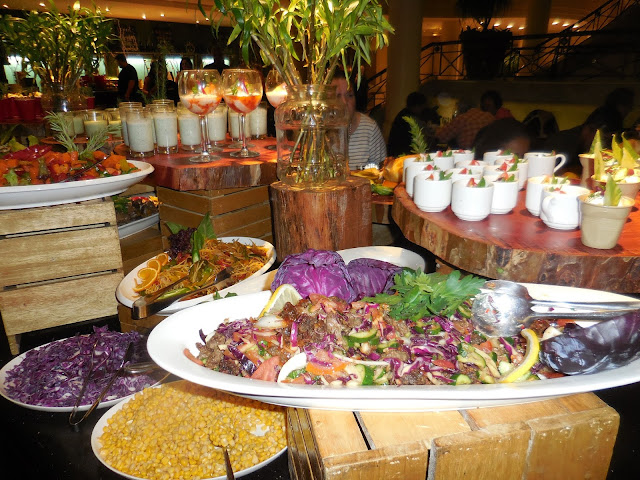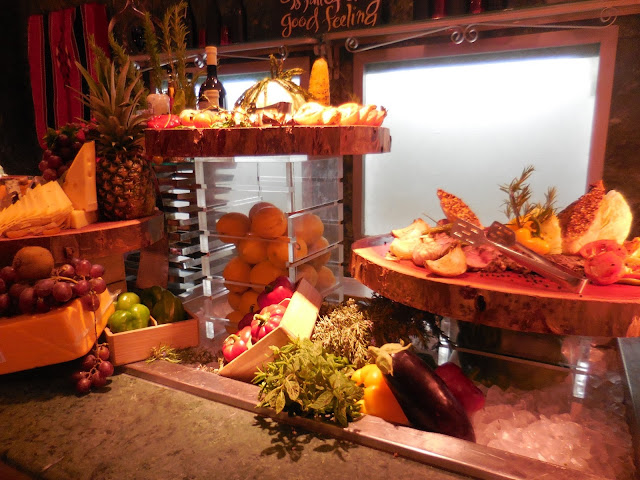Passover, Lent, Easter, and Kosher
 |
| So many dressings, sauces, and hummus. |
Israel’s culinary traditions comprise foods and cooking methods that
span 3,000 years of history. Over that time, these traditions
have been shaped by influences from Asia, Africa and Europe, and
religious and ethnic influences have resulted in a culinary melting pot.
 |
| Salads are great, but rarely do they include leafy greens. |
 |
| Many vegetables and hummus |
This post is all about the food in both Israel and Jordan. We had both breakfast and dinner at the various hotels we stayed at. Lunch was on our own, but like I said earlier, most of my lunches were simple as I usually didn't eat with the group. I may have mixed up the times we ate during Passover and had kosher food, but I've tried to keep them straight. I didn't take many photos during the Passover because, to tell you the truth, they got boring and were all the same. I will try and explain how the Jewish people eat during that time.
The food of the ancient Israelites was based on several products that still play important roles in modern Israeli cuisine. These were known as the 7 species: olives, figs, dates, pomegranates, wheat, barley and grapes. The diet, based on locally grown produce, was enhanced by imported
spices, readily available due to the country’s position at the
crossroads of east-west trade routes.
Breakfast Time
 |
| Love to start with some fruit |
 |
| Gotta have a couple of sweet pastries |
 |
| Various spreads to add to the dishes |
 |
| Raw fish for breakfast? Raw fish anytime? Eeww!! |
 |
| Different types of eggs, but you can always have an egg dish cooked in front of you, however you'd like. |
 |
| Cheeses galore (I only tried a couple the whole time I was in the Holy Land. I know, I'm crazy! |
|
Beginning with the first Aliyah in 1881, Jews began immigrating to the area from Eastern Europe in larger numbers, particularly from Poland and Russia. Vegetables such as zucchini, peppers, eggplant, artichoke, and chickpeas became a staple in their diet. The bread, olives, cheese and raw vegetables they adopted became the
basis for the kibbutz breakfast, which in more abundant forms is served
in Israeli hotels, and in various forms in most Israeli homes today
 |
| Eggplant is in many dishes - I love that! |
 |
| My friend, Dan, loves the bread bar. For a week we won't have it, however - it is almost Passover time and it's forbidden! |
 |
| Dinner time and I start out with a salad plate - tastes from several dishes. |
 |
| So many choices! |
 |
| Topping for the salad - flattened, herb dried bread....very good! |
 |
| Lots of varieties of olives - Tyler....you would like this! |
Israeli eating customs also conform to the wider Mediterranean region,
with lunch, rather than dinner, being the focal meal of a regular
workday. “Kibbutz foods” have been adopted by many Israelis for their
light evening meals as well as breakfasts, and may consist of various
types of cheeses, both soft and hard, yogurt, labne
and sour cream, vegetables and salads, olives, hard-boiled eggs or
omelets, pickled and smoked herring, a variety of breads, and fresh
orange juice and coffee.
Passover was from Mon, April 10 through Tues, April 18. When we went to Jordan on the 13th, we no longer had to think of Passover because most everyone was either Islam or Christian.
Passover:
- The Traditional Foods of Passover. Seder Plate. ...
- Wine.
Four glasses of kosher red wine are required at the Passover Seder,
each symbolizing one of the four promises made by God. ...
- No Grains That Ferment. The five that are excluded are wheat, rye, oats, barley and spelt. ...
- Matzo.
At a kibbutz lunch, we had a large salad bar, then these sauces were put out for us to use on flat bread. Very tasty!
 |
| Main dish was Falafel - fried chickpeas...so very tasty! |
Right about here is when we had some pretty boring, tasteless meals. Passover is observed for seven days in
Israel and eight days in the Diaspora. During Passover, the Jewish
kosher laws become a lot more challenging. Leavened and fermented grain
products are prohibited to commemorate freedom from Egyptian
slavery. When the Jews escaped Egypt (led by Moses), they didn’t have
time to let their breads rise before going into the desert. Because of
this, any type of leavened bread or bread product is prohibited during
Passover. These leavened products, known as chametz, include
certain grain-based foods like breads, pasta, pastries, breadcrumbs,
crackers, etc. Unleavened bread, aka “matzo,” traditionally takes the
place of chametz during Passover.
And for dessert - various dishes which were so great!
Joanne was observing Lent, so she gave up something - SWEETS! I admired her for it, knowing that I never could. She never ate anything sweet until Easter - WAY TO GO, Joanne!
Kosher means “fit” or “proper”– a concept associated with cleanliness, purity and extra supervision. Kosher observance is a historical, communal, and personal commitment,
and a connection to the will of the Creator. To those who observe
kosher, its concepts also offer reminders of lessons in kindness and
sensitivity to animals, attention to detail in everyday matters,
self-control, and thinking before acting.
I LOVE the whole theme and philosophy of "Kosher" - we can all learn from it!
- kosher menus separate dairy from meat products. It is
interesting to learn that iron and calcium are
not absorbed well when ingested together.
-the mandatory salting and rinsing of meat and poultry, has been studied
for its ability to reduce bacteria under certain
conditions
The Bible tells us what types of
animals, fish, and fowl are permitted — so it seems that all we have to
do is buy a chicken or a side of beef, and it will be kosher. However,
there is a bit more to it. We have to make sure that ALL the
requirements of the Torah are met before we can call a food kosher.
These requirements are different, depending on the food product
involved.
Let’s take meat for an example.
First, meat has to come from a kosher animal source. It’s pretty well
known that beef is a kosher animal source, and pigs are not. But after
the cow is selected, it needs to be checked for overall health. Then it
must be slaughtered according to the Torah guidelines by a shochet, a specialized rabbi, for internal signs of ill health.
If the animal passes the test, then
the blood must be removed from the meat, since the Torah does not allow
the blood to be eaten. This has to be done within a certain time limit.
Once the meat is cut into pieces, it will be rinsed, salted, and
rinsed again.
Only after all of these steps are taken properly, can the meat from this cow be called “kosher”.
 |
| We stayed at the Marriott Hotels while in Jordan - they went out of their way! |
 |
| It's all about PRESENTATION! |
Enjoy all my photos of the food. The cooks and servers always smiled when I entered the dining hall as they knew I was there at the beginning of the line to get photos. I couldn't leave any out, so there are MANY!!
 |
| Creme Brulet - I'm in Heaven...I mean Jordan! |
 |
| Roast Duck |
 |
| Oysters, I think |
 |
| Raw Salmon which I tried (very good) |
 |
| Octopus (which I tried BEFORE I knew) - WOW!! YUM! |
 |
| Paella was to die for! |
Here come the SWEETS!!
 |
| Rib Eye Steak - everyone LOVED this meat! Cooked outside on the grill to their liking! |
I will have our special Easter meal later on the post for Day 15. But for now - drool as you read this. As for me, I will look forward to my usual oatmeal for breakfast (which I really missed, by the way), large fresh salad (from our garden) for lunch - which I also missed, and beans for dinner (which I haven't missed! - sorry Rich!)





























































































No comments:
Post a Comment